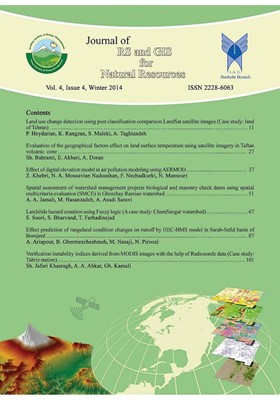Effect of digital elevation model in air pollution modeling using AERMOD
Subject Areas : Geospatial systems developmentZahra Khebri 1 , Narjes-Sadat Mousavian Nadoushan 2 , Farhad Nezhadkurki 3 , Nabiollah Mansouri 4
1 - MSc. Student of Environment, College of Natural Resources & Desert Studies, Yazd University
2 - PhD. Student of Environment, College of Environment and Energy, Islamic Azad University, Science and Research Branch
3 - Assoc. Prof. College of Natural Resources & Desert Studies, Yazd University
4 - Assoc. Prof. College of Environment and Energy, Islamic Azad University, Science and Research Branch, Tehran
Keywords:
Abstract :
Accordance with the importance of air pollutants and their effects on human health, assessment of air pollutant emission model's accuracy is significant. One of the models that widely used is AERMOD which is a permanent prediction model. The purpose of this research was evaluated the accuracy of AERMOD model, with and without application of topography. To achieve this goal, model ran with 24 hour meteorological data from Yazd synoptic station as input data and EAF stack monitoring data of I.A.S.Co. as the on-site data. Also, Global maper software version 13 was used for creating model's requirements for DEM format with different resolutions of 30, 50 and 90 meters. After that, model ran on both situations, flat and non-flat area (with applying topography), and then results compared together. The results indicated that the average concentration of pollutant in condition using topography is 0.036 µg/m3 higher than condition without usage topography. Also, the results showed the maximum concentration of pollutant in the case without using AERMAP, is 1 µg/m3 in opposite direction to the prevailing wind, in stack western direction and with using AERMAP, the maximum concentration is equal to 17.5 in prevailing wind direction in stack eastern and south eastern direction. Furthermore, by usage DEM with different resolutions, little difference was found in the mean concentrations predicted by the model. The result is that without implementation of AERMAP, the prediction was not sufficiently accurate. Furthermore, AERMAP could also be run with DEM 90 m and finally model could run.
1. اشرفی، خ.، م. شفیعپور، م. سلیمانیان و م. ر. مومنی. 1391. تعیین میزان انتشار و مدلسازی نحوه پراکنش آلایندههای ترکیبات آلی فرار ناشی از تبخیر سطحی از مخازن ذخیرهای واقع در منطقه عسلویه. محیطشناسی، 38(63): 47-60.
2. اشرفی، خ.، پ. فرکوراوند، ف. نژادکورکی و م. سلیمانیان. 1391. تحلیل حساسیت نتایج مدل AERMOD نسبت به تغییر پارامترهای کاربری اراضی. همایش ملی جریان و آلودگی هوا. 24 الی 25 آبان ماه. تهران.
3. پژویان، ج. و ن. مرادحاصل. 1386. بررسی اثر رشد اقتصادی بر آلودگی هوا. پژوهشهای اقتصادی، 7(4): 141-160.
4. شریفی، م. 1388. بررسی آلودگی هوای ناشی از پایانه مسافربری در بافت شهری اطراف آن. پایاننامه کارشناسی ارشد، گروه مهندسی عمران- محیط زیست، دانشکده محیط زیست، دانشگاه تهران. 110 صفحه.
5. عباسی چالشتری، ل. 1391. تأثیر تغییر ابعاد و موقعیت سازههای صنعتی و ارتفاع دودکشهای صنایع بر خروجی مدل AERMOD. پایاننامه کارشناسی ارشد، دانشکده منابع طبیعی، دانشگاه یزد. 100 صفحه.
6. عمید، م. 1388. مدلسازی انتشار آلایندههای تولیدی در مجتمع پتروشیمی بوعلی سینا. پایاننامه کارشناسی ارشد، دانشکده محیط زیست، دانشگاه تهران. 148 صفحه.
7. فرکوراوند، پ. 1391. بررسی آنالیز حساسیت مدل AERMOD در برآورد انتشار آلودگی هوای ناشی از صنایع. پایاننامه کارشناسی ارشد، دانشکده منابع طبیعی، دانشگاه یزد. 120 صفحه.
8. Agency UEP. 2004. Users Guide For The AERMOD Terrain Preprocessor (AERMAP). Office of Air Quality Planning and Standards Emissions, Monitoring and Analysis Division Research Triangle Park, North Carolina 27711, EPA-454/B-03-003. 106 pp.
9. Agency UEP. 2004. User's Guide for the AMS/EPA Regulatory Model-AERMOD. Office of Air Quality Planning and Standards Research Triangle Park, NC, EPA-454/B-03-001.
10. Bhardwaj KS. 2005. Examination of sensitivity of land use parameters and population on the performance of the AERMOD model for an urban area. MSc. Thesis, The University of Toledo. 160 pp.
11. Cimorelli AJ, Perry SG, Venkatram A, Weil JC, Paine RJ, Wilson RB, Lee RF, Peters WD, Brode RW. 2005. AERMOD: A dispersion model for industrial source applications. Part I: General model formulation and boundary layer characterization. Journal of Applied Meteorology, 44(5): 682-693.
12. Cimorelli AJ, Perry SG, Venkatram A, Weil JC, Paine RJ, Wilson RB, Lee RF, Peters WD, Brode RW, Paumier J. 2004. AERMOD: descriptionof model formulation”. U.S. Environmental Protection Agency, Office of Air Quality. Planning and Standards, Emissions Monitoring and Analysis Division, Research Triangle Park, North Carolina, EPA-454/R-03-004, 91 pp.
13. Heckel PF, LeMasters GK. 2011. The use of AERMOD air pollution dispersion models to estimate residential ambient concentrations of elemental mercury. Water, Air & Soil Pollution, 219(1-4): 377-388.
14. Holmes NS, Morawska L. 2006. A review of dispersion modelling and its application to the dispersion of particles: an overview of different dispersion models available. Atmospheric Environment, 40(30): 5902-5928.
15. Kho WF, Sentian J, Radojevic M, Tan C, Law P, Halipah S. 2007. Computer simulated versus observed NO2 and SO2 emitted from elevated point source complex. International Journal of Environmental Science & Technology, 4(2): 215-222.
16. Onofrio M, Spataro R, Botta S. 2011. The role of a steel plant in north-west Italy to the local air concentrations of PCDD/Fs. Chemosphere, 82(5): 708-717.
17. Perry SG, Cimorelli AJ, Paine RJ, Brode RW, Weil JC, Venkatram A, Wilson RB, Lee RF, Peters WD. 2005. AERMOD: A dispersion model for industrial source applications. Part II: Model performance against 17 field study databases. Journal of Applied Meteorology, 44(5): 694-708.
18. Venkatram A, Isakov V, Yuan J, Pankratz D. 2004. Modeling dispersion at distances of meters from urban sources. Atmospheric Environment, 38(28): 4633-4641.


